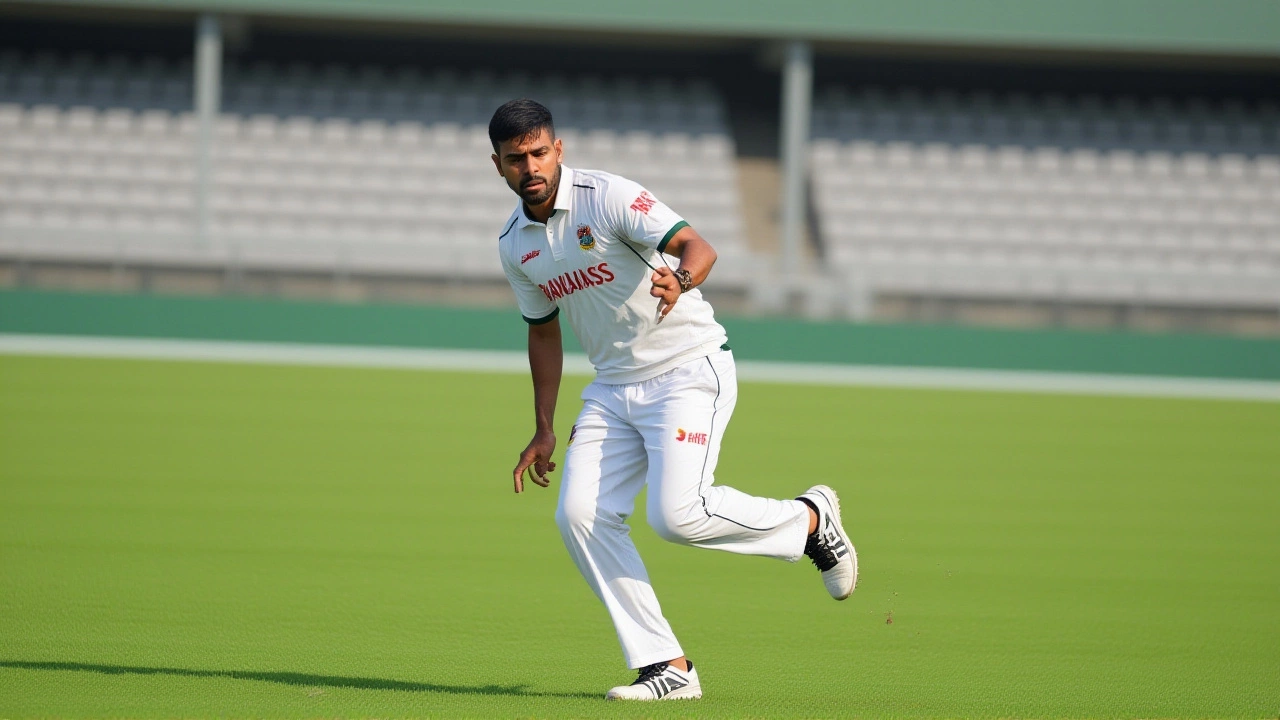On the fifth day of the second Test at the Sher-e-Bangla National Cricket Stadium in Mirpur, Dhaka, Taijul Islam did something no Bangladeshi bowler had ever done — he took his 250th Test wicket, surpassing Shakib Al Hasan as the nation’s all-time leading wicket-taker in Test cricket. The moment came just after lunch on November 22, 2025, when he clean-bowled Andy McBrine with a delivery that drifted in, dipped sharply, and clipped the top of off stump. It wasn’t just a wicket. It was history. And it sealed a 2-0 series sweep for Bangladesh against Cricket Ireland, their first-ever Test series win over the Irish.
A Record Years in the Making
Taijul Islam, born February 7, 1992, didn’t burst onto the scene with fireworks. He arrived quietly in 2014, taking 5 for 135 on debut against the West Indies in Kingstown. But over the next 11 years, he became the quiet architect of Bangladesh’s spin dominance. He broke Shakib’s record for most wickets in a single Test innings back in 2018, taking eight against New Zealand. Now, with 250 Test scalps, he’s the first Bangladeshi to reach triple digits in both Tests and ODIs. What’s remarkable isn’t just the number — it’s how he got there. No express pace. No yorker magic. Just drift, dip, and an uncanny ability to exploit the turning Mirpur pitch.
The Match That Made History
Bangladesh didn’t just win — they dictated every phase. Their first innings total of 476, built on centuries from Mominul Haque (87) and Shadman Islam (78), gave them control. Ireland, bowled out for 265 in reply, were already on the back foot. Then came the declaration.
At 297 for 4 in 69 overs, captain Najmul Hossain Shanto called time just before tea. Not because they were safe — but because they wanted to force a result. It was a bold move. And it worked. Ireland, chasing 509, collapsed under the weight of expectation. Taijul Islam, already on 3 for 55 from the fourth day, returned to dismantle their middle order. He had Andy Balbirnie and Paul Stirling out for 26 before lunch on day five. Stephen Doheny, who survived three dropped chances, was finally out lbw for 15. Harry Tector fought hard with 50, but Mushfiqur Rahim’s tumbling catch at slip ended his resistance.
Only Curtis Campher (63*) offered resistance, but even he couldn’t carry the burden alone. Hasan Murad chipped in with 2 for 35, removing Cade Carmichael and Tector, while Ireland’s Gavin Hoey, with 2 for 84, was their only bowler to make meaningful inroads.

The Human Element Behind the Numbers
What made this win special wasn’t just the stats. It was the quiet dignity of Taijul Islam. He didn’t celebrate wildly. Didn’t scream. Didn’t leap. He just nodded, turned, and walked back to his mark. His teammates mobbed him moments later — but the moment belonged to him alone.
And then there was Mushfiqur Rahim. At 38, the veteran wicketkeeper-batsman scored 53 not out in the second innings — his 24th Test fifty — and took that stunning catch to dismiss Tector. He’s been around since Bangladesh’s earliest Test days. To see him and Taijul, two men who’ve carried this team through its darkest years, share this moment? That’s the real story.
Why This Matters Beyond Bangladesh
This series win isn’t just a national milestone. It’s a statement. Ireland, granted Test status in 2017, are still finding their feet. But Bangladesh, once considered minnows, now have the depth, the strategy, and the spin mastery to dominate even established teams. Taijul Islam’s 250 wickets place him among the elite left-arm spinners in history — only five others have reached it: Daniel Vettori, Shahid Afridi, Reece Topley, John Emburey, and Shakib Al Hasan (who, ironically, was the record-holder until yesterday).
And here’s the twist: Taijul never played a single T20I. He’s a Test purist. While others chase franchise leagues, he’s stayed loyal to the longest format. That’s rare. And it’s why his legacy might outlast even the most flashy modern stars.

What’s Next?
Bangladesh now turns its attention to the upcoming home series against Sri Lanka in January. With Taijul Islam at his peak and Hasan Murad emerging as a reliable second spinner, their attack looks formidable. Meanwhile, Ireland must decide whether to invest more in spin-friendly pitches or rebuild their batting order — especially against turning tracks.
For Taijul, the next milestone? 300 wickets. It’s not impossible. He’s still 33. He’s still hungry. And he’s still bowling with the precision of a surgeon.
Frequently Asked Questions
How does Taijul Islam’s 250 Test wickets compare globally?
Taijul Islam is the sixth left-arm spinner in history to reach 250 Test wickets, joining legends like Daniel Vettori and Shahid Afridi. Globally, he ranks 21st among all bowlers in Test history. Only 12 bowlers have taken more wickets than him — including Muttiah Muralitharan (800) and Shane Warne (708). His achievement is especially notable as he’s the first from a non-traditional Test nation to reach this mark since 2010.
Why was Najmul Hossain Shanto’s declaration so crucial?
Declaring at 297 for 4 with 11 overs left before tea gave Bangladesh just enough time to bowl Ireland out in a single session. Had they batted longer, Ireland might have survived into the next day. Shanto’s decision, backed by the pitch’s increasing turn, turned a potential draw into a certain win. It was a masterstroke in match management — something Bangladesh rarely showed in earlier eras.
What made the Mirpur pitch so effective for Taijul Islam?
The Sher-e-Bangla pitch, known for its dry, dusty surface, deteriorates rapidly after four days. It offers consistent turn and variable bounce — perfect for left-arm orthodox spinners like Taijul. Unlike faster pitches, it doesn’t reward aggressive batting. Ireland’s middle order, unused to such conditions, struggled to adjust, often playing across the line and getting trapped lbw or bowled through the gate.
How does this affect Bangladesh’s World Test Championship prospects?
Bangladesh’s 2-0 series win adds vital points to their WTC standings. With only five matches left in Cycle 3, this victory lifts them above West Indies and Sri Lanka in the standings. A strong showing against Sri Lanka in January could secure a top-six finish, guaranteeing a home Test final. Taijul’s form and the team’s improved discipline make them genuine contenders for the first time.
What’s next for Cricket Ireland after this defeat?
Ireland’s defeat exposes their fragility against quality spin. Their next Test series, against Afghanistan in May 2026, will be a litmus test. They need to develop spin-friendly home pitches and invest in batting technique against turn. Without that, they’ll keep losing to teams like Bangladesh, who now have the tactical edge in such conditions.
Is Taijul Islam likely to play beyond 2027?
At 33, Taijul is in the prime of his spin career. Unlike fast bowlers, spinners often peak later. He’s shown no signs of decline — his economy rate remains below 2.8 runs per over. With Bangladesh’s next major Test series against England and Australia in 2027, he’s almost certain to be selected. If he stays fit, 300 wickets is realistic — and he’s the only Bangladeshi who can realistically reach it.

